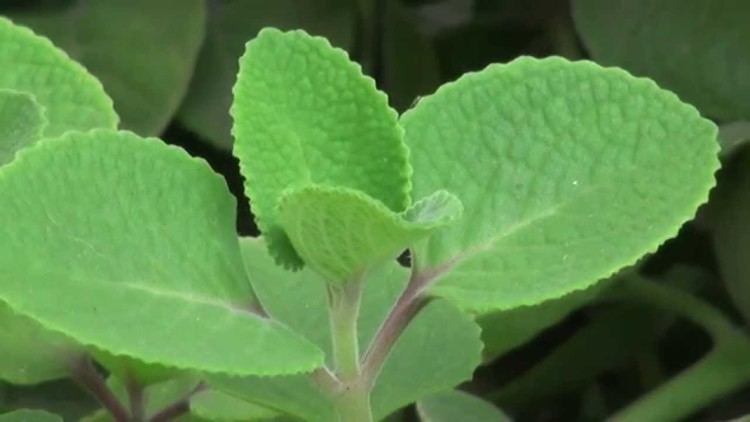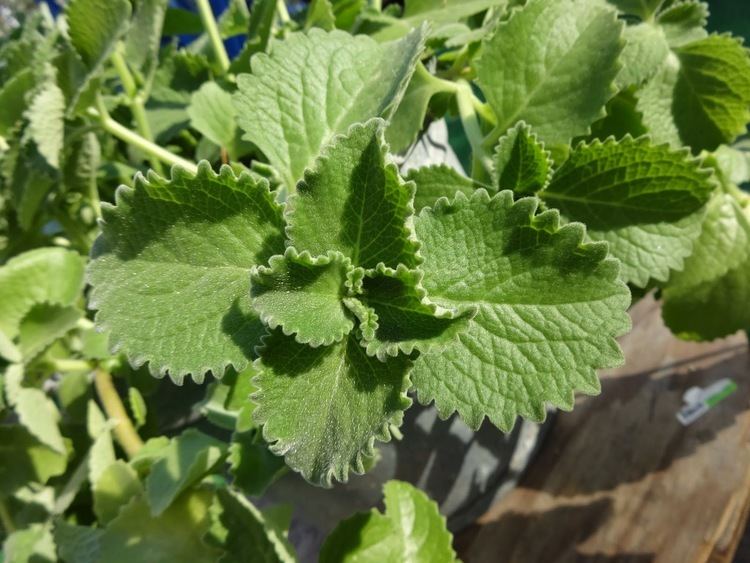Rank Species | Genus Plectranthus Higher classification Plectranthus | |
 | ||
Similar Plectranthus, Coleus, Glebionis coronaria Clade Tracheophytes, Angiosperms, Eudicots, Asterids Species C. amboinicus Binomial name Coleus amboinicus | ||
Our tallest oregano plectranthus amboinicus
Plectranthus amboinicus, once identified as Coleus amboinicus, is a tender fleshy perennial plant in the family Lamiaceae with an oregano-like flavor and odor, native to Southern and Eastern Africa, from South Africa (KwaZulu-Natal) and Swaziland to Angola and Mozambique and north to Kenya and Tanzania. It is widely cultivated and naturalised elsewhere in the Old and New World tropics. It is used as a decorative plant in many houses in south India.
Contents
- Our tallest oregano plectranthus amboinicus
- Cuban oregano plectranthus amboinicus
- Description
- Uses
- Cultivation
- Common names
- Literature
- References

Cuban oregano plectranthus amboinicus
Description

Plectranthus amboinicus is a large succulent herb, fleshy and highly aromatic, much branched, possessing short soft erect hairs, with distinctive smelling leaves. The stem is fleshy, about 30–90 cm, either with long rigid hairs (hispidly villous) or tomentose (densely covered with soft, short and erect hairs, pubescent). Leaves are undivided (simple), broad, egg/oval-shaped with a tapering tip (ovate) and very thick, they are pubescent (thickly studded with hairs), with the lower surface possessing the most numerous glandular hairs, giving a frosted appearance. The taste of this leaf is pleasantly aromatic with agreeable and refreshing odour. Flowers are on a short stem (shortly pedicelled), pale purplish in dense whorls at distant intervals in a long slender raceme.
Uses

The leaves are strongly flavoured and make an excellent addition to stuffings for meat and poultry. Finely chopped, they can also be used to flavour meat dishes, especially beef, lamb and game. Such use as a flavouring and its geographic spread is indicated by some of the common names, and documented for Cambodia and South Africa It is also used as a vegetable, for example in South East Asia. The herb is used as a substitute for oregano in the food trade and food labelled "oregano-flavour" may well contain this herb.

The leaves have also had many traditional medicinal uses, especially for the treatment of coughs, sore throats and nasal congestion, but also for a range of other problems such as infections, rheumatism and flatulence. The plant is cultivated in home-gardens throughout India for use in traditional medicine, being used to treat malarial fever, hepatopathy, renal and vesical calculi, cough, chronic asthma, hiccup, bronchitis, helminthiasis, colic, convulsions, and epilepsy, Shenoy and others refer to further Indian traditional medicinal uses such as for skin ulcerations, scorpion bite, skin allergy, wounds, diarrhoea, with emphasis on the leaves being used as a hepatoprotective, to promote liver health. In Indonesia Plectranthus amboinicus is a traditional food used in soup to stimulate lactation for the month or so following childbirth. In Cambodia 2 uses are recorded: juice from the leaves is sweetened and then given to children as protection from colds; and leaves are applied to the lips. In Bahia, Brasil, people use the plant to treat skin lesions caused by Leishmania braziliensis. Just to the north, in Paraiba of the same country, the plant was extremely commonly known for use in home medication. As noted above, medicinal use also occurs in Southern India, it also documented in other parts of South East Asia and South Africa.
Other uses include as an ornamental, and for its essential oils.
Cultivation

Indian borage is very commonly grown as a potted plant; it is a fast-growing plant. Propagation is by stem cuttings.

This herb thrives in locations that offer well-drained soil and partial shade. It is sensitive to frost and is best suited for USDA hardiness zones 10-11, making it ideal for subtropical and tropical environments. However, it can also adapt to cooler climates when cultivated in a pot. In such cases, it should be moved indoors or to a warm, protected area during winter. The plant requires minimal watering, emphasizing the need for a sparing approach to irrigation.
Common names
Literature
Some published literature on the plant includes:
